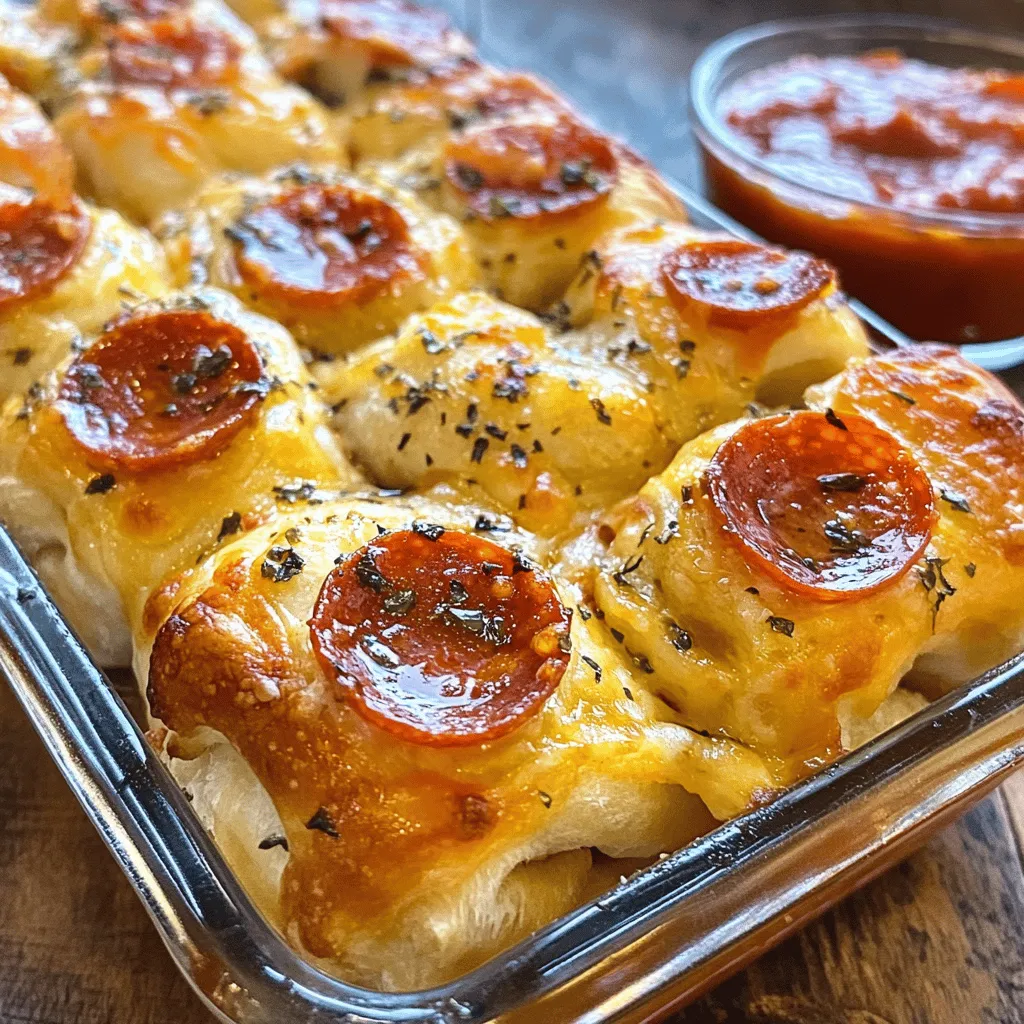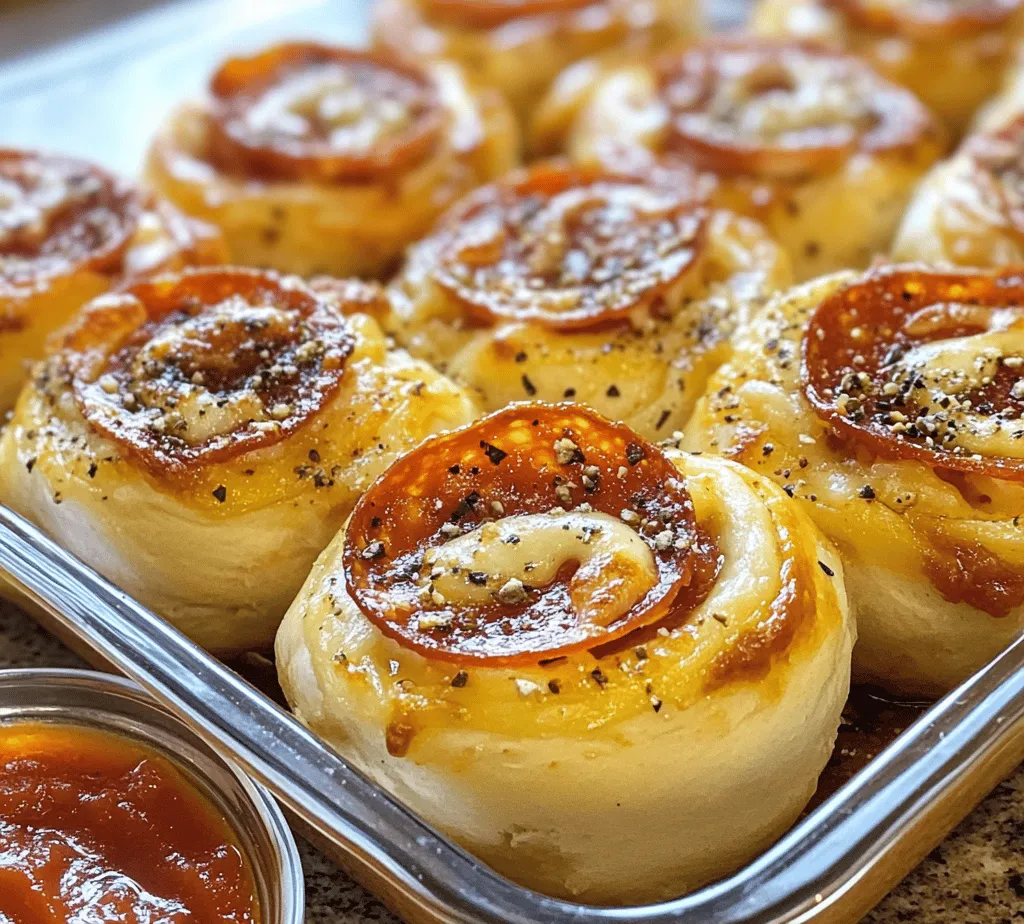Introduction
Understanding the allure of Pepperoni Rolls, a beloved comfort food that combines savory pepperoni, gooey cheese, and soft bread, is essential for any food enthusiast. These delightful rolls are not only packed with flavor but also serve as an excellent snack or appetizer for any gathering. Their satisfying combination of crispy exterior and chewy interior makes them irresistible to both kids and adults alike. Whether you’re hosting a game day party, a family gathering, or simply looking for a comforting treat to enjoy on a cozy evening, Pepperoni Rolls are sure to impress.
In this article, we will delve deep into the recipe for Pepperoni Rolls, providing clear instructions, tips for success, and a bit of history behind this delightful dish. From the initial mixing of the dough to the final golden-brown bake, we’ll guide you through the entire process, ensuring your rolls turn out perfectly every time.
The Origins of Pepperoni Rolls
To truly appreciate Pepperoni Rolls, it’s important to explore their cultural significance. These rolls trace their roots back to Italian-American cuisine, where they emerged as a convenient and flavorful way to enjoy the traditional Italian ingredients of pepperoni and cheese. The story goes that during the early 1920s, Italian coal miners in West Virginia began creating these rolls as a portable meal. They would fill dough with pepperoni and cheese, allowing them to take a satisfying lunch that could be easily consumed on the job.
As the years passed, Pepperoni Rolls gained popularity beyond the mining communities. They became a staple in local bakeries and pizzerias, not just in West Virginia, but across the United States. Their practicality and rich flavors resonated with a broader audience, making them a beloved snack for sports events, family gatherings, and holiday celebrations. Today, Pepperoni Rolls are celebrated as a quintessential American comfort food, representing a delicious fusion of Italian heritage and American ingenuity.
Ingredients Breakdown
Before diving into the preparation of Pepperoni Rolls, let’s take a closer look at the essential ingredients that contribute to their mouthwatering taste and texture.
– All-Purpose Flour: This versatile staple serves as the backbone of the dough, providing the structure necessary to create fluffy yet firm rolls. The quality of the flour can affect the texture, so opt for a high-protein all-purpose flour for the best results.
– Active Dry Yeast: This ingredient is crucial for creating the perfect rise in your dough. Yeast ferments the sugars in the flour, producing carbon dioxide that causes the dough to expand and become light and airy. Always check the expiration date on your yeast to ensure it’s active.
– Olive Oil: Adding a rich flavor and enhancing the dough’s texture, olive oil helps keep the rolls moist. It also contributes to browning during baking, giving the rolls a desirable golden color.
– Pepperoni: As the star ingredient, pepperoni provides a savory and slightly spicy kick to each bite. You can choose traditional pepperoni or opt for turkey or vegetarian alternatives for a healthier option.
– Cheese Varieties: For a delectable flavor profile, we recommend using a combination of mozzarella and Parmesan cheese. Mozzarella melts beautifully, providing a gooey texture, while Parmesan adds a sharp, nutty flavor that complements the pepperoni perfectly.
Preparation Steps
Now that we’ve covered the ingredients, let’s walk through the initial preparation steps for creating your Pepperoni Rolls. Each step is crucial in ensuring that your rolls turn out perfectly.
1. Activating the Yeast
The first step in making Pepperoni Rolls is to activate the yeast. This process is vital as it ensures that the yeast is alive and ready to work its magic in the dough.
– Method: In a small bowl, combine warm water (about 110°F) with a teaspoon of sugar and the active dry yeast. Stir gently until the yeast dissolves. Let the mixture sit for about 5-10 minutes until it becomes frothy. This bubbling action indicates that the yeast is alive and ready to be incorporated into the dough.
2. Mixing Dry Ingredients
While the yeast is activating, you can prepare the dry ingredients.
– Step: In a large mixing bowl, combine the all-purpose flour and a pinch of salt. The salt is essential not only for flavor but also for controlling the yeast’s fermentation process. Mixing the dry ingredients ensures that the salt is evenly distributed, which is crucial for achieving a uniform flavor throughout the rolls.
3. Combining Mixtures
Once the yeast is activated, it’s time to bring everything together.
– Step: Create a well in the center of the flour mixture and pour in the activated yeast mixture along with the olive oil. Use a wooden spoon or your hands to combine the ingredients until they start to form a cohesive dough. The goal here is to incorporate the flour and yeast mixture thoroughly without overworking the dough.
4. Kneading Techniques
Kneading is an essential step that helps develop the gluten in the dough, giving the rolls their desirable texture.
– Step: Transfer the dough to a lightly floured surface and begin kneading. Push the dough away from you with the heels of your hands, then fold it back over itself. Turn the dough a quarter turn and repeat this process for about 8-10 minutes. The dough should become smooth and elastic. If it feels too sticky, sprinkle a little more flour as you knead, but be careful not to add too much, as this can lead to tough rolls.
Rising Techniques
Understanding the importance of dough rising is crucial to achieving the perfect Pepperoni Rolls.
1. First Rise
After kneading, it’s time to let the dough rise. This step allows the yeast to do its job, creating air bubbles that will give your rolls their light and fluffy texture.
– Step: Place the kneaded dough in a lightly greased bowl, cover it with a clean kitchen towel or plastic wrap, and set it in a warm, draft-free area. Ideally, the dough should rise until it doubles in size, which usually takes about 1-2 hours. To check if the dough is ready, gently press your finger into it; if the indentation remains, the dough has risen sufficiently.
Following these steps will set you on the right path to making delicious Pepperoni Rolls. Each stage is essential in developing the flavor and texture that make these rolls such a beloved comfort food. In the upcoming sections, we will continue to guide you through the remaining steps of crafting the perfect Pepperoni Rolls, including shaping, filling, and baking. Stay tuned for the continuation of this delicious journey!
Second Rise: Enhancing Flavor and Texture
The second rise is a crucial step in making Pepperoni Rolls, as it allows the dough to develop a deeper flavor and a light, airy texture. After shaping your rolls, cover them with a clean kitchen towel or plastic wrap, and let them rest in a warm, draft-free environment for about 30-45 minutes. This final rise will give your rolls that perfect, pillowy softness that contrasts beautifully with the savory filling.
Filling the Rolls
Crafting the perfect assembly of flavors is essential for creating delicious Pepperoni Rolls. Here, the filling is just as important as the dough itself.
Choosing the Right Cheese: Mozzarella vs. Other Options
When it comes to cheese, mozzarella is a popular choice for its meltability and mild flavor. It complements the spicy pepperoni without overpowering it. However, feel free to experiment with different types of cheese to suit your taste:
– Provolone: Offers a sharper flavor profile that pairs well with pepperoni.
– Cheddar: Adds a rich, tangy taste that can elevate the overall flavor of the roll.
– Monterey Jack: Known for its creamy texture and mild flavor, it can add a smooth mouthfeel.
Mixing cheeses can also create a delightful blend. For instance, combining mozzarella with a bit of sharp cheddar can provide depth and complexity to your rolls.
Arranging the Pepperoni: Layering for Maximum Flavor
For optimal flavor distribution in your Pepperoni Rolls, consider how you layer the pepperoni. Start by placing a slice of cheese at the center of the dough, followed by a few slices of pepperoni. Be sure to distribute the pepperoni evenly, and don’t hesitate to add more if you want a heartier filling. For an extra punch, consider adding a sprinkle of Italian seasoning or crushed red pepper flakes to the filling.
Sealing the Rolls: Techniques for Preventing Spills During Baking
Properly sealing your rolls is crucial to prevent any filling from leaking out during baking. Here are some effective techniques:
1. Pinch and Fold: After placing your filling in the center, pinch the edges of the dough together firmly. Fold the edges over the filling, ensuring that no cheese or pepperoni is exposed.
2. Use Egg Wash: Brushing the edges of the dough with a beaten egg before sealing can create a stronger bond. The egg wash acts as glue, helping the edges stay together during baking.
3. Twist and Seal: For a fun twist on the traditional roll, take the ends of the dough and twist them together to create a secure seal that also adds a unique presentation.
Baking the Rolls
With the rolls filled and sealed, it’s time to bake them to perfection.
Preheating the Oven: Importance of Temperature Control
Preheating your oven to 375°F (190°C) is vital for achieving that perfect bake. An adequately preheated oven ensures that the rolls rise properly and develop a nice golden crust. This step is not just about cooking the dough; it also affects the overall flavor and texture of your Pepperoni Rolls.
Brushing with Olive Oil: Ensuring a Golden Finish
Before baking, brush the tops of your rolls with a light coating of olive oil. This step not only adds flavor but also helps achieve that beautiful golden-brown color. For an extra touch, you can sprinkle some garlic powder or grated Parmesan cheese on top after brushing with olive oil, adding a savory aroma and enhancing the flavor profile.
Baking Times: Decoding When They Are Perfectly Done
The baking time for your Pepperoni Rolls will typically range from 15 to 20 minutes, but keep an eye on them as they bake. You want the rolls to be golden brown on the outside and cooked through on the inside. A good test for doneness is to tap the bottom of a roll; if it sounds hollow, they are ready to come out of the oven. Let them cool for a few minutes before serving to avoid burning your mouth on the hot filling.
Serving Suggestions
Pepperoni Rolls are versatile and can be served in various ways that cater to different occasions.
Pairing with Marinara Sauce: Why It’s the Perfect Dip
One of the best ways to enjoy your Pepperoni Rolls is by pairing them with a side of marinara sauce for dipping. The tangy, rich flavor of marinara complements the savory taste of the rolls, creating a delightful contrast. You can make your marinara sauce at home or use a store-bought version for convenience.
Serving as an Appetizer or Snack: Versatility of the Rolls
These rolls can serve many purposes. They make excellent appetizers for parties, game days, or family gatherings. If you’re looking for a quick snack, they can be enjoyed warm or at room temperature, making them a perfect finger food option that everyone will love.
Presentation Ideas for Gatherings: Making Your Dish Stand Out
To elevate the presentation of your Pepperoni Rolls, consider serving them on a wooden board or a decorative platter. You can garnish the dish with fresh herbs like basil or parsley for a pop of color. Adding small bowls of marinara sauce, ranch dressing, or even a spicy aioli can make the dish more inviting and interactive.
Nutritional Information
Understanding the nutritional aspects of Pepperoni Rolls can help you enjoy them mindfully.
Caloric Content per Serving
On average, one Pepperoni Roll contains about 250-300 calories, depending on the size and the amount of filling used. This makes them a satisfying treat without being overly indulgent.
Breakdown of Macronutrients
Each roll generally contains:
– Carbohydrates: Approximately 30-35 grams, mainly from the dough.
– Protein: Around 10-12 grams, coming from the cheese and pepperoni.
– Fats: Roughly 12-15 grams, primarily from the cheese and olive oil used in the recipe.
Considerations for Dietary Needs
If you have dietary restrictions or preferences, consider these alternatives:
– Vegetarian Options: Replace pepperoni with vegetables like bell peppers, mushrooms, or spinach. You can also use plant-based pepperoni for a meat-free version.
– Gluten-Free Dough: For a gluten-free option, use a gluten-free flour blend to make your dough. Ensure that your other ingredients are also gluten-free.
Conclusion
Pepperoni Rolls are more than just a tasty treat; they represent comfort, tradition, and creativity in the kitchen. By following this guide, you can master the art of making these rolls at home, impressing friends and family alike. With a few simple ingredients and techniques, you will create a dish that not only satisfies the palate but also brings warmth and joy to any occasion. Whether enjoyed fresh from the oven or dipped in marinara sauce, these Pepperoni Rolls are sure to become a staple in your culinary repertoire. So roll up your sleeves, gather your ingredients, and enjoy the delightful process of making and sharing Pepperoni Rolls that everyone will adore.



